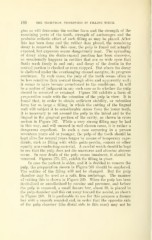Page 422 - My FlipBook
P. 422
188 THE TECHNICAI, PEOCEDmBES IN PILLING TEETH. ;
gins as will determine the outline foi'm and the strength of the
remaining parts of the tooth, strength of anchorages and the
probable esthetic etfect of such filling as may be placed. After
this has been done and the rubber dam placed, the remaining
decay is removed. In this case, the pulp is found not actually
exposed, but exposure seems dangerously near. The spreading
of decay along the dento-enamel junction has been excessive,
as occasionally happens in cavities that are so wide open that
fluids wash freely in and out; and decay of the dentin in the
central portion is checked or even stopped. But where the decay
is sheltered under the overhanging enamel margins, its progress
continues. In such cases, the pulp of the tooth seems often to
be less sensitive than normal though alive and apparently well
it seems to have become accustomed to the conditions. It will
be a matter of judgment in any such case as to whether the pulp
should be removed or retained. Figure 266 exhibits a form of
preparation made with the retention of the pulp in view. It is
found that, in order to obtain sufficient stability, or retention
form for so large a filling, in which the cutting of the lingual
wall will subject it to considerable stress from the lower teeth,
it is necessary to cut around the pulp to the labial and to the
lingual in the gingival portion of the cavity, as shown in cross
section in Figure 267. While a very strong filling may be had
in this way, and will succeed in well chosen cases, it is rather a
dangerous expedient. In such a case occurring in a person
seventeen years old or younger, the puli? of the tooth should be
kept alive for several years longer by means of temporary expe-
dients, such as filling with white gutta-percha, cement or other
equally non-conducting material. A careful watch should be kept
to see that the pulp does not die unawares and alveolar abscess
occur. In case death of the pulp seems imminent, it should be
removed. Figures 270, 271, exhibit the filling in place.
In case the patient is older, and it is decided to remove the
pulp, the preparation shown in Figure 268 should be employed.
The outline of the filling will not be changed. But the pulp
chamber may be used as a safe, firm anchorage. The manner
of cutting this is shown in Figure 269. Wlien the pulp has been
devitalized or anesthetized by cocaine and pressure, and before
the pulp is removed, a small fissure bur, about 10, is placed in
the pulp chamber and this cut away toward the mesial, as shown
in Figure 269. It is preferable to use for this purpose a fissure
bur with a smooth rounded end, in order that the opposite side
of the pulp chamber (the distal side in this case) may not be


